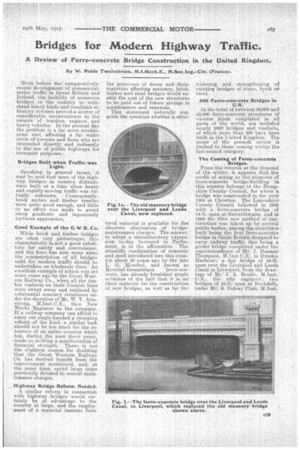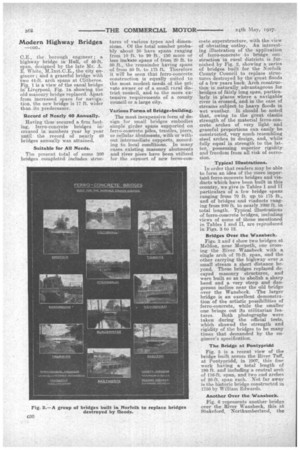Bridges for Modern Highway Traffic.
Page 5

Page 6

Page 8

If you've noticed an error in this article please click here to report it so we can fix it.
A Review a Ferro-concrete Bridge Construction in the United Kingdom.
By W. Noble Twelvetrees, Ni.I.Mech,E., M.Soc.ing.-Civ. (France).
Even before the comparativelyrecent development of corninercial-1 Motor traffic in Great -Britain and Ireland, the inability of nuinerous bridges in the -country to withstand heavy loads and resultant vibratory stresses proved.a source of considerable inconvenience to the
owners traction engine's and heavy. vehicles. In the present day the, problein is a far more troublesome one; • affecting a far, • wider circle of Persons and firms who are' interested directly and indirectly in the',Use of public highways for tron.-3port purposes.
Bridges Built when Traffic was Light.
Speaking in general terms, -it• may be said that most of the .highway bridges in country -diitricts were built at a time when heavy and .rapidly-moving traffic was vir tually.. unknown. Consequently, brick arches and timber trestles were quite good enough, and little or no :effort was made to avoid steep gradients and ingeniously tortuous approaches.
Good Example of Me G.W.R. Co.
While brick and timber bridges are often very picturesque, this characteristic is not a good substitute for safety and convenience, arid the time has now come when the".reeonstruction of all bridges unfit for modern traffic should be undertaken on wholesale lines. An excellent example Of action .wa.S set some years age by the Great Western Railway Co., when all the timber viaducts on their Cornish lines were swept away and replaced by substantial masonry structures under the direction of Mr. W. Y. Armstrong, M.Inst.C.E.. then New Works Engineer to the company. If a railway company can afford to -carry out single-handed a sweeping reform of the kind, a similar task should not be too much for the resources of an entire. country which has, during the past three years, made so striking a manifestation of financial strength. There. is not the slightest reason for doubting that the Great Western Railway Co. has derived benefit from the improvement mentioned, and, at the same time, Saved large sums previously devoted to annual maintenance charges.
Highway Bridge Reform Needed.
A similar reform in connection with -highway bridges would certainly be of advantage to the country at large, and the employment of a material immune from the processes of decay and disin-: tegration: affecting masonry, brick, timber and steel bridges would enable the cost of the new structures to be paid out of future savings in maintenance and renewals.
This statement naturally suggests the question whether a struc
tural material is available for the absolute elimination of bridgemaintenance charges. The answer, to adopt a circumlocutoryexpression. to-day favoured. in Parliament, is in the affirmative. The S'eientific combination of concrete and steel introduced into this 'country about 20, years ago by the late L. G. Mouchel, and known as Mouchel-Ilennebique ferro-concrete, has already furnished ample evidence of the ft that it is an ideal material for the construction of new bridges, as well as for the widening and . strengthening , of existing bridges of stone, brick or steel .
. 500 Ferro-concrete Bridges in U.K.
in the total of between30;000 and 4%000 ferro-concrete -structures of various kinds completed in all parts _of. the world, are included nearly 2000 bridges and viaduCts, of which more than 300 have been built in the United Kingdom. • The scope • of the presort% review is limited to those coming within the last-named category.
The Coming of Ferro-concrete Bridges.
From the records at the disposal of the writer, it appears that the credit of acting as the pioneers of ferro-concrete bridge-building in this eduntry belongs to the Hampshire County•Council, for whom .a bridge was constructed in the year 1900 at Chewton. The Lancashire County Council followed in 1902 with a ferro-concrete bridge of 44-ft. span at Satterthwaite, and in 1903 the then new method of con-. struction was talceri up by several public bodies, among the structures built being the first ferro-concrete bridge in Great Britain designed to carry railway, traffic-, this being a girder bridge completed under the superintendence of .Mr. J. Hannay . Thompson, M.Inst.O.E., in Dundee . Harbour.; a fine bridge of 50-ft. • span over the Liverpool and Leeds Canal in LiVerpool, from the drawings of Mr: J. A. Brodie, M.Inst. C.E., the city engineer ; two bridges of 45-ft: span. at Rochdale, under M. S. Sidney Platt, M.Inst. C.E., the borough engineer; highway bridge in Hull, of 40-ft. span, designed by the late Mr. A. E. White, M.Inst.C.E., the city engineer; and a graceful bridge with two 44-ft. arch spans at Clitheroe. Fig. 1 is a view of the canal bridge in Liverpool, Fig. la showing the old masonry bridge replaced. Apart from increased space for navigation, the new bridge is 17 ft. wider than its predecessor.
Record of Nearly 40 Annually.
Having thus secured a firm• footing, ferro-concrete bridges creased in numbers year by year until the record of nearly 40 bridges annually was attained.
Suitable for All Needs.
The present total of some 300 bridges completed ineludes strue tures of various types and dimensions. Of the total number probably about 50 have spans ranging from 10 ft. to 20 ft., 150 more or less ineintie spans of from 20 ft. to 50 ft., the remainder having spans of from 50 ft. to 175 ft. Therefore it will be seen that ferro-concrete construction is equally suited to the most modest needs of the private owner or of a small rural district council, and to the more extensive requirements of a county council or a large city.
Various Forms of Bridge-building.
The most inexpensive form of design for small bridges embodies simple girder, spans supported on ferro-concrete piles, trestles, piers or cellular abutments, wither without intermediate supports, according to local conditions. In many cases existing masonry abutments and river piers have been utilized for the support of new ferro-con
.crete superstructure, with the view of obviating outlay. An interesting illustration of the application of ferro-ooncrete to bridge construction in rural districts• is furnished by Fig. 2, showing a series of bridges built for the Norfolk County Council to replace structures destroyed by the great floods of a few years back. Arch construction is naturally advantageous for bridges of fairly long span, particularly in places where a navigable river is crossed, and in the ease of streams subject to heavy floods in wet weather. It should be noted that, owing to the great elastic strength of the material ferro-concrete arches of very light and graceful proportions can easily be constructed, very much resembling steel arches in design, and, while fully equal in strength to the latter, possessing superior rigidity and freedom from all risk of corrosion.
Typical Illustrations.
In order that readers may be able to form an idea of the more importa.ht ferro-concrete bridges and viaducts which have been built in this country, we give in Tables I and II particulars of a few bridge spans ranging from 70 ft. up to 175 ft., and of bridges and viaducts ranging from 200 ft. to nearly 1000 ft. in total length. Typical illustrations of ferro-concrete -bridges, including views of some of those mentioned in Tables I and II, are reproduced in Figs. 3 to 12.
Bridges Over the Wansbeck.
Figs. 3 and 4 show two bridges at Me/don, near Morpeth, one crossing the River Wansbeck with a single arch of 70-ft. span, and the other carrying the highway over small stream a short distance beyond. These bridges replaced decayed masonry structures, and were built so as to abolish a sharp bend and a very steep and dangerous incline near the old bridge over the Wansbeck. . The larger bridge is an excellent demonstration of the artistic possibilities of ferro-concrete, while the smaller one brings out its utilitarian features. Both photographs were taken during the official tests, which showed the strength and rigidity of the bridges to be many times that demanded by the engineer's specification.
The Bridge at Pontypridd Fig. 5 is a reeent view of the bridge built across the River Taff, at Pontypridd, in 1907, this fine work having a total length of 1811 ft. and including a central arch of 116-ft. span, and two end arches of 26-ft. span each. Not far away is the historic bridge constructed in 1750 by William Edwards.
Another Over the-Wansbeck.
Fig. 6 represents another bridge over the River Wansbeek, this at Stakeford, Northumberland, the structure taking the place of an old bridge at Sheepwa.sh . and a dangerous ford -across the river. The total length of the work is 264 ft. between abutinents, and. the river spans are carried by braced piers
as shown in the illustration. It was originally intended to erect a steel bridge at an estimated cost of .212,000, but it was afterwards de cided to adopt ferro-commete, with the result that £5000 were saved in first cost, to say nothing of the annual saving represented by the elimination of all maintenance charges.
A Useful Type,at Cattawade, Fig. 7 shows a most useful type of bridge over the River Stour, at ' Cattawade, near Manningtree. Situated between the counties of Essex and Suffolk, the bridge in eludes six gii.der spans of. 28 ft. .10 ins., and hasa total length of 232 ft.. The structure was tested first with A traction engine, then with two steam rollers, and finally with a procession. of. three steam rollers, the maximum deflection being only one-twelfth of an inch instead of nearly I in. which ,was the deflection permitted by the con,tract conditions.
(To COi2Chtded)




















